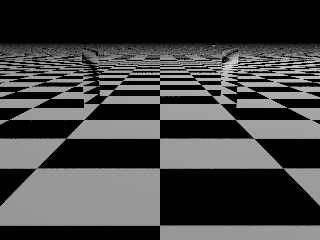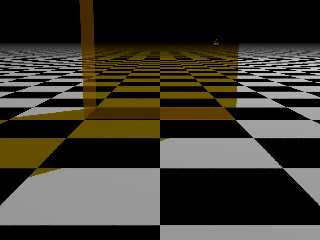|
 |
I found an issue when rendering a scene that included a quartic object with a
water-like texture and interior, and a transparent box, (intended to hold
media), in the same scene. The original discussion can be found here:
https://news.povray.org/povray.binaries.images/thread/%3Cweb.62b4a6ddb354b68f4ebf5035cc1b6e%40news.povray.org%3E/
I was able to simplify the scene down to just a few elements that cause the
problem to appear, and have attached a scene file. (It doesn't appear to depend
on the resolution or AA settings in the render).
In the scene, there is a quartic "drip" with translucent texture and an ior of
1.33 sitting behind a hollow box with a transparent pigment. When I render it,
the sides of the box become visible and seem to take on the texture/interior of
the drip rather than the completely transparent texture I assigned.
I will attach a sample rendering in a follow-up post.
-- Chris R.
Post a reply to this message
Attachments:
Download 'qbug.pov.txt' (2 KB)
|
 |
|
 |
"Chris R" <car### [at] comcast net> wrote:
> I found an issue when rendering a scene that included a quartic object with a
> water-like texture and interior, and a transparent box, (intended to hold
> media), in the same scene. The original discussion can be found here:
>
>
https://news.povray.org/povray.binaries.images/thread/%3Cweb.62b4a6ddb354b68f4ebf5035cc1b6e%40news.povray.org%3E/
>
> I was able to simplify the scene down to just a few elements that cause the
> problem to appear, and have attached a scene file. (It doesn't appear to depend
> on the resolution or AA settings in the render).
>
> In the scene, there is a quartic "drip" with translucent texture and an ior of
> 1.33 sitting behind a hollow box with a transparent pigment. When I render it,
> the sides of the box become visible and seem to take on the texture/interior of
> the drip rather than the completely transparent texture I assigned.
>
> I will attach a sample rendering in a follow-up post.
>
> -- Chris R.
Here's a quick rendering of the bug net> wrote:
> I found an issue when rendering a scene that included a quartic object with a
> water-like texture and interior, and a transparent box, (intended to hold
> media), in the same scene. The original discussion can be found here:
>
>
https://news.povray.org/povray.binaries.images/thread/%3Cweb.62b4a6ddb354b68f4ebf5035cc1b6e%40news.povray.org%3E/
>
> I was able to simplify the scene down to just a few elements that cause the
> problem to appear, and have attached a scene file. (It doesn't appear to depend
> on the resolution or AA settings in the render).
>
> In the scene, there is a quartic "drip" with translucent texture and an ior of
> 1.33 sitting behind a hollow box with a transparent pigment. When I render it,
> the sides of the box become visible and seem to take on the texture/interior of
> the drip rather than the completely transparent texture I assigned.
>
> I will attach a sample rendering in a follow-up post.
>
> -- Chris R.
Here's a quick rendering of the bug
Post a reply to this message
Attachments:
Download 'qbug.png' (57 KB)
Preview of image 'qbug.png'

|
 |
|
 |
On 6/27/22 10:23, Chris R wrote:
> In the scene, there is a quartic "drip" with translucent texture and an ior of
> 1.33 sitting behind a hollow box with a transparent pigment. When I render it,
> the sides of the box become visible and seem to take on the texture/interior of
> the drip rather than the completely transparent texture I assigned.
The short explanation
---------------------
It's an issue with infinite shapes and inside determination which, here,
can be fixed by manually bounding - and then rendering turning the
stripping of user bounding(+ur) off with -ur.
I used a sloppy bounding box shape of:
bounded_by { box {
<-10, 0.1, -2>,
<10, 20.1, +2>
}
}
A longer and still wildly incomplete description
--------------------------------------------------
The polynomial shape is generally treated as an infinite shape unless
the user manually bounds it - and users always should... The
insided-ness of any particular region - on seeing surfaces as the ray
'travels' becomes a flip of the coin without bounding(a). The shapes:
cubic, quartic and poly have long been mapped to the polynomial shape
internally(b).
(a) - Lying some. The better the manual bounding the smaller the lies.
(b) - Even the older explicit shape code often had similar issues as do
shapes still with custom code like the quadric(b1).
(b1) - Which itself has unreliable auto-bounding - which at its worst
differs depending upon CPU/compilers/build settings as reported a few
years ago.
Some background. Internally, there is an initial atmospheric IOR value
which is 1.0 unless changed in code as there is no way to access it via
SDL. At any surface a working IOR is calculated based on the transition
from the current IOR to the one specified by the new surface. The
infinite shapes IOR value, if inside that shape, get used instead for
the 'about to exit region' IOR value(c).
(c) - Yes, I think where we have >1 infinite shape testing as initially
inside, what happens or even knowing what should happen is likely messy.
Other SDL ways to verify what is happening.
------------------------------------------
- We can add and interior { ior 1.33 } to the box making its IOR same as
the infinite ior (from the not really inside inside ior of 1.33).
- We can flip the insided-ness of the quartic to be correct by adding
the 'inverse' keyword rather than by adding user/manual bounding, but
this a less 'good' option.
- We can trip the issue with the infinite plane rather than the quartic
by changing to 'plane { -y, 0 ... } and setting the interior ior to 1.33.
- Things like a sphere with inverse, an ior of 1.33 and all boudning
off(d) should work as a trigger too, but I didn't try it.
(d) - This an experiment which cannot be done with official v3.7/v3.8
versions because -mb doesn't fully turn off bounding as it did in v3.6
and prior.
Other random ramblings
----------------------
- The quartic drop is inside the box.
- The drops IOR treatment is backward in cases where it showed up in the
shipped test case.
- In my povr branch once it was getting the proper IOR / insided-ness
treatments it was a noisy result without 'sturm on'. Probably similar
will be seen in official releases, but povr's solvers are different.
- The issue here is not at all tangled in the order reduction code
problems in the shipped versions of POV-Ray as I supposed might be so in
the binary images group thread.
- I changed the scene so the box is using filtered transparency and a
partially transparent inside texture to better see the box.
- Image attached with the user bounding in place and using -ur to turn
off the stripping of such user bounding.
- It should be once user bounding is in place you can flip renders
between -ur and +ur and see the infinite shape count reported in the
text output change.
- How the insided-ness gets done is different shape to shape. I'm not
sure the user bounding get's used to 'initialize' the insided-ness in
all shapes. It might be inverse is sometimes needed too(e)
(e) - IIRC a few old shapes don't handle inverse correctly (quadrics one
I think).
- Anytime the inside test is off/wrong resulting csg can be too, though,
this not an issue with unions.
Bill P.
Post a reply to this message
Attachments:
Download 'story.png' (182 KB)
Preview of image 'story.png'

|
 |
|
 |
On 6/30/22 04:26, William F Pokorny wrote:
> - It should be once user bounding is in place you can flip renders
> between -ur and +ur and see the infinite shape count reported in the
> text output change.
My sleeping dreams...
On waking this morning I had the thought the above statement likely
only applies with my povr branch where the +ur/-ur behavior has no
exceptions.
The official POV-Ray branches have hidden, user bounds stripping
exceptions. I'd make a moderate bet the polynomial shape is one of those
exceptions. If right, the infinite count will NOT go up with +ur in the
official POV-Ray branches - and the render result won't revert.
Bill P.
Post a reply to this message
|
 |




![]()